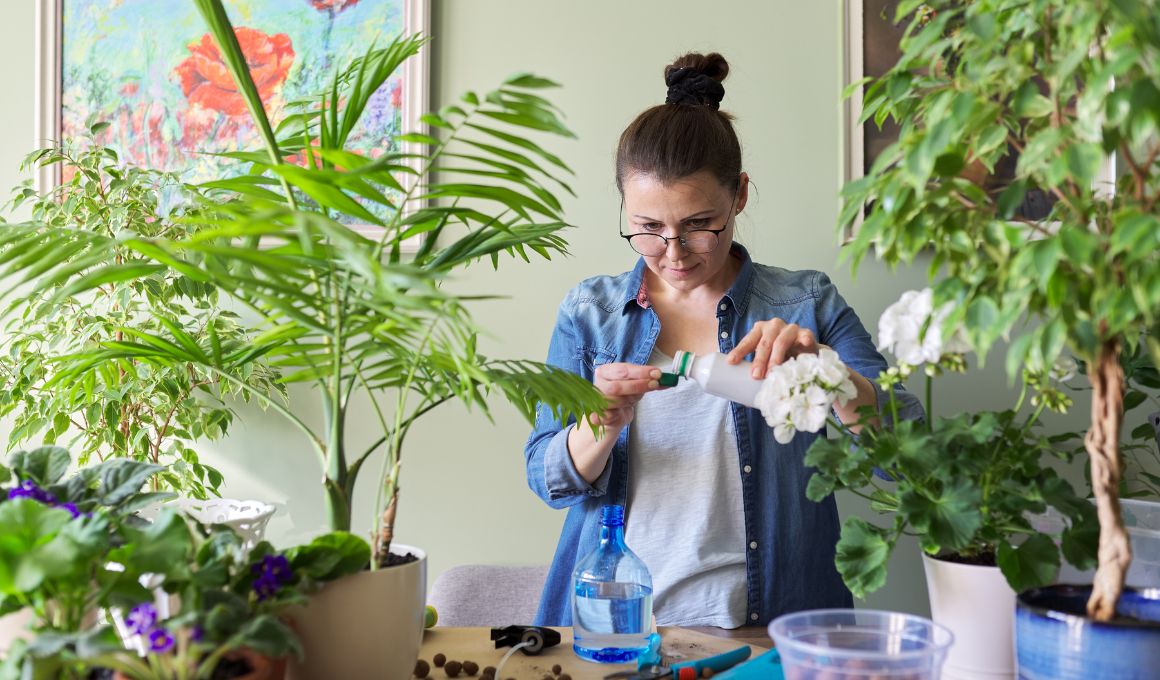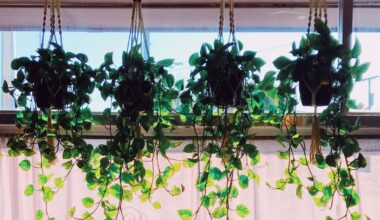Welcome to our comprehensive guide to fertilizer for indoor plants! Indoor plants bring life and beauty to any space, but they rely on us to provide them with the essential nutrients they need to thrive.
In this article, we will delve into the world of indoor plant fertilizers, exploring their importance, types, application techniques, and much more.
Whether you’re a seasoned indoor gardener or just starting your plant journey, this guide will equip you with the knowledge to keep your leafy companions healthy and vibrant.
What is Indoor Fertilizer?
Indoor fertilizer, also known as houseplant fertilizer, is specifically formulated to meet the nutritional needs of plants grown indoors. Unlike outdoor plants, indoor plants have limited access to natural nutrients found in garden soil.
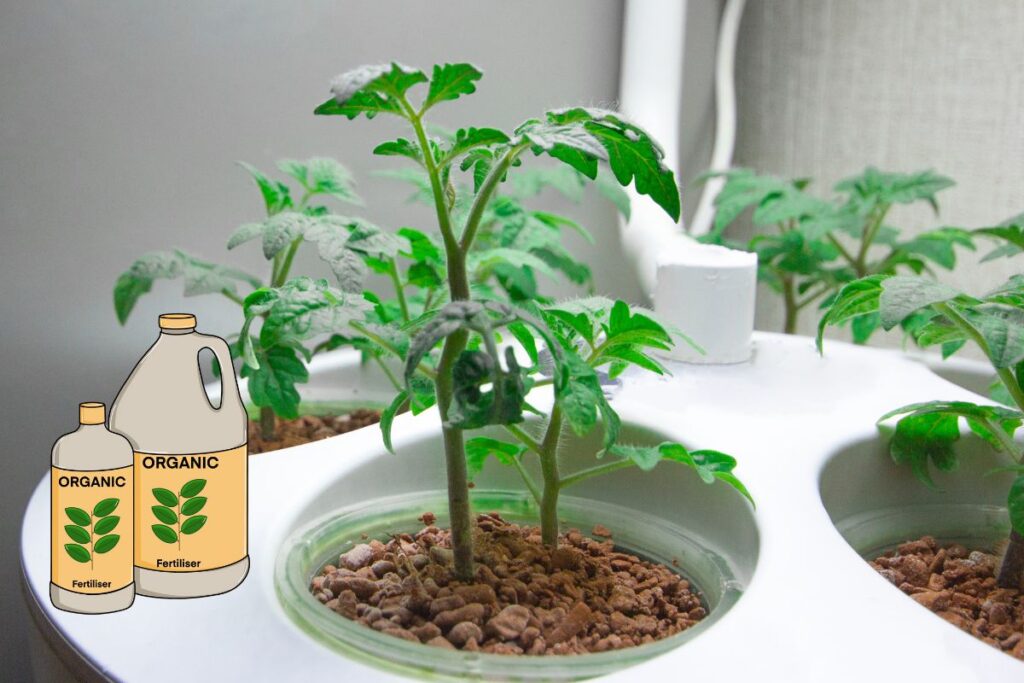
Indoor fertilizers are designed to provide essential macronutrients (nitrogen, phosphorus, and potassium) and micronutrients to support healthy growth, foliage, and flowering of indoor plants. They come in various forms, such as liquid, granular, or slow-release, and can be tailored to different types of indoor plants.
How do I know when my indoor plants need fertilizer?
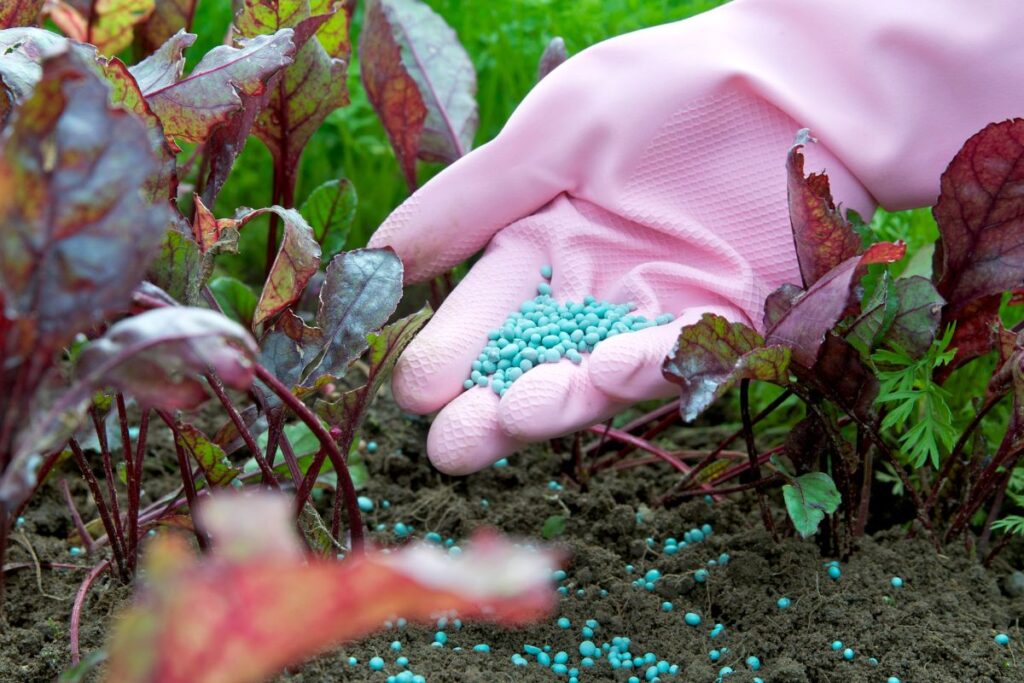
Observing the signs and understanding the needs of your indoor plants is crucial in determining when they require fertilizer. While indoor plants generally need fertilization during the growing season, which is typically in spring and summer, it’s important to pay attention to their overall health and appearance.
Here are some indicators that your indoor plants may be in need of fertilizer:
- Pale or Yellow Leaves: If you notice that the leaves of your indoor plants are turning pale or yellow, it could be a sign of nutrient deficiency. Fertilizer provides essential nutrients that can help restore the vibrant green color of the foliage.
- Stunted Growth: Slow or stunted growth can be an indication that your indoor plants are lacking nutrients. If you notice that your plants are not growing as vigorously as they should, it may be time to provide them with a boost of fertilizer.
- Lack of Flowering: Indoor plants that are not flowering or producing blooms as expected might benefit from a fertilizer application. Flowers require specific nutrients to develop, and a lack of these nutrients can hinder blooming.
- Soil Depletion: Over time, the nutrients in the soil can become depleted as the plants utilize them for growth. If you’ve had your indoor plants for a while and haven’t fertilized them recently, it’s a good idea to consider fertilizing to replenish the nutrient levels in the soil.
- Slow Recovery from Pruning or Repotting: When you prune or repot your indoor plants, they may experience stress and require extra nutrients to recover. Fertilizing after such activities can aid in their rejuvenation and promote healthy regrowth.
It’s important to note that while these signs may indicate a need for fertilizer, it’s also crucial to ensure that other factors such as light, water, and proper care are not causing the observed issues. Assess the overall health of your plants and consider fertilizer as part of a comprehensive care routine.
By closely observing your indoor plants and responding to their specific needs, you can provide them with the necessary fertilizer to support their growth, vitality, and overall well-being. Remember to choose a fertilizer that is suitable for indoor plants and follow the instructions for application. With proper fertilization, your indoor plants will thrive and bring beauty to your living space.
Related Reading:
- A Comprehensive Guide to the Different Types of Evergreen Trees
- Discovering the Majesty of Tropical Plants: A Guide to Growing Tropical Plants and Care
- Snake Plant – A Growing, Types, Benefits Guide
- How to Get Started with Gardening?
- An Overview of Cucurbitaceae Family
Fertilizer for Indoor Plants
To understand the significance of fertilizers for indoor plants, it’s crucial to grasp their role in providing essential nutrients that are often lacking in indoor environments. Indoor plants, confined to pots and lacking access to natural soil ecosystems, rely solely on the nutrients we provide them through fertilization.
Here is a list of popular fertilizer products for indoor plants:
- Miracle-Gro Indoor Plant Food: Miracle-Gro offers a range of indoor plant food products that provide essential nutrients for healthy growth and vibrant foliage. Their indoor plant food is available in both liquid and spike form.
- Osmocote Indoor Smart-Release Plant Food: Osmocote’s indoor plant food is a slow-release fertilizer that provides continuous feeding for up to six months. It is designed to meet the specific nutritional needs of indoor plants.
- Jobe’s Organics Indoor Fertilizer Spikes: Jobe’s Organics offers organic fertilizer spikes specially formulated for indoor plants. These spikes gradually release nutrients into the soil to nourish plants and promote strong root development.
- Schultz All Purpose Liquid Plant Food: Schultz All Purpose Liquid Plant Food is a versatile fertilizer suitable for both indoor and outdoor plants. It provides a balanced blend of essential nutrients for optimal plant growth.
- Espoma Indoor! Liquid Plant Food: Espoma’s Indoor! Liquid Plant Food is an organic fertilizer formulated specifically for indoor plants. It contains a rich blend of nutrients derived from natural sources to support healthy growth.
- Dr. Earth Organic Indoor Plant Fertilizer: Dr. Earth offers an organic indoor plant fertilizer that is safe for both people and pets. This fertilizer is enriched with beneficial microbes and mycorrhizae to enhance soil health and plant growth.
- Grow More Indoor Plant Food: Grow More Indoor Plant Food is a water-soluble fertilizer that provides a balanced mix of essential nutrients for indoor plants. It is suitable for use in various growing mediums, including soil and hydroponics.
- Fox Farm Liquid Nutrient Trio: Fox Farm’s Liquid Nutrient Trio consists of three fertilizers—Grow Big, Big Bloom, and Tiger Bloom—that work together to provide the necessary nutrients for different stages of plant growth. It is widely used by indoor gardening enthusiasts.
- General Hydroponics Flora Series: The General Hydroponics Flora Series is popular among indoor hydroponic growers. This three-part nutrient system (FloraGro, FloraMicro, and FloraBloom) allows precise control of nutrient ratios for optimal plant performance.
- EarthPods Premium Indoor Plant Food: EarthPods offers convenient, premeasured plant food capsules for indoor plants. These slow-release pods contain a balanced blend of organic nutrients that gradually release into the soil, nourishing plants over time.
By replenishing the soil with essential elements, we ensure that our indoor plants have the necessary building blocks for growth, vibrant foliage, and healthy root development.
Why is Fertilizer Important for Indoor Plants?
Indoor plants, just like their outdoor counterparts, require a balanced diet of macronutrients and micronutrients to thrive. While natural soil ecosystems typically provide these nutrients, indoor plants rely on us to supplement their diet.
Fertilizers play a vital role in fulfilling this need by replenishing the soil with key elements such as nitrogen (N), phosphorus (P), and potassium (K), along with other essential micronutrients like iron (Fe), manganese (Mn), and zinc (Zn). These nutrients are crucial for plant growth, photosynthesis, and overall health.
Understanding Indoor Plant Nutritional Needs
Each indoor plant has unique nutritional requirements, so it’s essential to understand their specific needs. Different plants may have varying preferences for nitrogen, phosphorus, and potassium ratios, as well as the need for additional micronutrients.
Researching the specific requirements of your indoor plants will help you choose the appropriate fertilizer and ensure optimal growth and vitality.
Types of Indoor Plant Fertilizers

When it comes to fertilizers for indoor plants, there are several types to consider, each with its own advantages and application methods. Let’s explore the most common types:
- Liquid Fertilizers: Liquid fertilizers are popular among indoor plant enthusiasts due to their ease of use and quick absorption. They come in concentrated forms that can be diluted with water before application. Examples of liquid fertilizers include:
- All-purpose liquid fertilizers: These fertilizers contain a balanced ratio of nitrogen, phosphorus, and potassium (NPK) to support overall plant growth and development.
- Specialized liquid fertilizers: Some liquid fertilizers are formulated specifically for certain types of plants, such as flowering plants, foliage plants, or succulents, to meet their specific nutritional requirements.
- Granular Fertilizers: Granular fertilizers are solid, slow-release fertilizers that gradually release nutrients into the soil over an extended period. They are typically applied by sprinkling the granules on the soil surface. Examples of granular fertilizers for indoor plants include:
- Osmocote: Osmocote is a popular slow-release granular fertilizer that provides a steady supply of nutrients to plants over several months.
- Controlled-release fertilizers: These fertilizers release nutrients based on temperature and moisture conditions, ensuring a continuous and balanced plant nutrient supply.
- Organic Fertilizers: Organic fertilizers are derived from natural sources and are rich in organic matter, providing a slow and steady release of nutrients. They are often preferred by those seeking natural and sustainable options. Examples of organic fertilizers for indoor plants include:
- Compost: Compost made from kitchen scraps, yard waste, or worm castings is an excellent source of organic matter and nutrients for indoor plants.
- Fish emulsion: Fish emulsion is a liquid organic fertilizer made from decomposed fish. It is high in nitrogen and provides a nutrient boost to plants.
- Water-Soluble Fertilizers: Water-soluble fertilizers are powders or crystals that dissolve in water and can be applied during regular watering. They provide an immediate nutrient supply to the plants. Examples of water-soluble fertilizers include:
- Miracle-Gro: Miracle-Gro is a popular brand of water-soluble fertilizer that is widely used for both indoor and outdoor plants.
- Hydroponic fertilizers: These specialized water-soluble fertilizers are designed for plants grown in hydroponic systems, where nutrients are delivered directly to the roots in a water-based solution.
- Natural Homemade Fertilizers: If you prefer a DIY approach, you can create your own homemade fertilizers using natural ingredients. Some common examples include:
- Banana peel fertilizer: Banana peels are rich in potassium and can be dried, ground, and mixed with water to create a potassium-rich liquid fertilizer.
- Eggshell fertilizer: Crushed eggshells are a source of calcium and can be added to the soil or infused in water to provide calcium to plants.
Remember to follow the instructions provided by the manufacturer or adjust the application rates as needed to avoid overfertilization. Each type of fertilizer has its own recommended usage guidelines, so it’s important to read and follow them for optimal results.
Choose a fertilizer that suits your indoor plants’ needs, considering their growth stage, light requirements, and nutritional requirements. Regular fertilization and proper watering and light conditions will help your indoor plants thrive and maintain their health and vibrancy.
Choosing the Right Fertilizer for Your Indoor Plants
When selecting a fertilizer for your houseplants, consider factors such as the plant’s nutritional needs, growth stage, and the type of fertilizer you prefer.
It’s essential to choose a well-balanced fertilizer that provides the necessary macronutrients and micronutrients.
Reading product labels and understanding the NPK ratio (nitrogen-phosphorus-potassium) will help you make an informed decision.
When to Fertilize Indoor Plants?
Indoor plants have specific fertilization requirements, and timing plays a crucial role in their overall health. Generally, indoor plants are fertilized during the growing season, which is typically spring and summer.
During this time, plants are actively growing and have higher nutrient demands. However, it’s essential to follow the specific instructions provided by the manufacturer and consider the individual needs of your plants.
How to Fertilize Indoor Plants?

Proper application techniques are crucial to ensuring effective fertilization without causing harm to your indoor plants. Let’s walk through the process step-by-step:
Preparation
- Select the right fertilizer: Choose a fertilizer that suits your indoor plants’ needs and growth stage. Consider whether you prefer a liquid, granular, organic, or slow-release option.
- Read the instructions: Carefully read and follow the manufacturer’s instructions for the chosen fertilizer. Pay attention to the recommended dosage, application frequency, and any specific guidelines.
- Prepare the watering can or sprayer: If you’re using liquid or water-soluble fertilizers, prepare the watering can or sprayer by cleaning it thoroughly to avoid any residual chemicals from previous use.
Application Techniques
Water the plants: Before applying the fertilizer, water your indoor plants to ensure the soil is moist. This helps prevent root burn and aids in nutrient absorption.
- Apply the fertilizer: Depending on the type of fertilizer, follow the instructions for the correct dosage and application method. For liquid fertilizers, dilute them with water as recommended and apply directly to the soil. For granular fertilizers, spread them evenly on the soil surface or mix them into the soil.
- Avoid direct contact: When applying liquid fertilizers to house plants, avoid direct contact with the leaves, as this can cause damage. If any fertilizer accidentally splashes on the foliage, rinse it off promptly with clean water.
- Water after fertilization: After applying the fertilizer, thoroughly water the plants to ensure the nutrients are distributed evenly throughout the soil. This helps prevent fertilizer burn and ensures proper nutrient uptake.
- Monitor and adjust: Regularly monitor your indoor plants for signs of nutrient deficiencies or overfertilization. Adjust the fertilization frequency or dosage if necessary to meet the plant’s needs.
How to Make Homemade Fertilizer for Indoor Plants?

Making homemade fertilizer for indoor plants is a cost-effective and eco-friendly option. Here’s a simple recipe to create your own organic fertilizer:
Ingredients:
- Banana peels
- Eggshells
- Coffee grounds
Instructions:
- Collect banana peels, eggshells, and used coffee grounds.
- Allow the banana peels to dry out for a few days.
- Grind the dried banana peels, eggshells, and coffee grounds separately into a fine powder.
- Mix equal parts of the banana peel powder, crushed eggshells, and coffee ground powder in a bowl.
- Store the homemade fertilizer mixture in an airtight container.
To use the homemade fertilizer, sprinkle a small amount on the soil surface around your indoor plants and gently work it into the top layer of the soil. Water the plants as usual. Remember to use homemade fertilizer sparingly and adjust the amount based on your plants’ needs.
Best Homemade Fertilizer for Indoor Plants
Creating your own homemade fertilizer allows you to provide natural and organic nourishment to your indoor plants. Here are a few homemade fertilizer options that are effective for indoor plants:
Homemade Plant Food without Ammonia
Ingredients:
- Compost or vermicompost
- Epsom salt
- Molasses
- Water
Instructions:
- In a gallon-sized container, mix 1 part compost or vermicompost with 10 parts water.
- Stir in 1 tablespoon of Epsom salt and 1 tablespoon of molasses.
- Let the mixture steep for 24 to 48 hours, stirring occasionally.
- Strain the liquid to remove any solid particles.
- Dilute the liquid fertilizer by mixing 1 part of the concentrated fertilizer with 4 parts water.
- Use diluted homemade plant food to water your indoor plants once every two weeks.
This homemade fertilizer provides a balanced blend of nutrients and beneficial microorganisms, promoting healthy growth and overall plant well-being.
Signs of Overfertilization to Indoor Plants
While fertilizer is essential for plant growth, overfertilization can have adverse effects on your indoor plants. Watch out for the following signs, indicating that your plants may be receiving too many nutrients:
- Leaf burn or discoloration: Overfertilized plants may exhibit scorched or yellowed leaves, particularly at the tips or edges.
- Stunted growth: If your plants are not growing as expected or showing signs of stunted growth, excessive fertilization could be the culprit.
- Salt buildup: Excess fertilizer salts can accumulate in the soil over time. Look for a white crust on the soil surface or the sides of the pot, indicating the presence of salt buildup.
- Wilting or root damage: Overfertilization can disrupt the water balance in plants, leading to wilting, root damage, or root rot.
- Poor flower or fruit production: If your flowering indoor plants are not blooming or producing fruits, it could be a result of overfertilization.
Common Mistakes to Avoid Fertilizing Indoor Plants
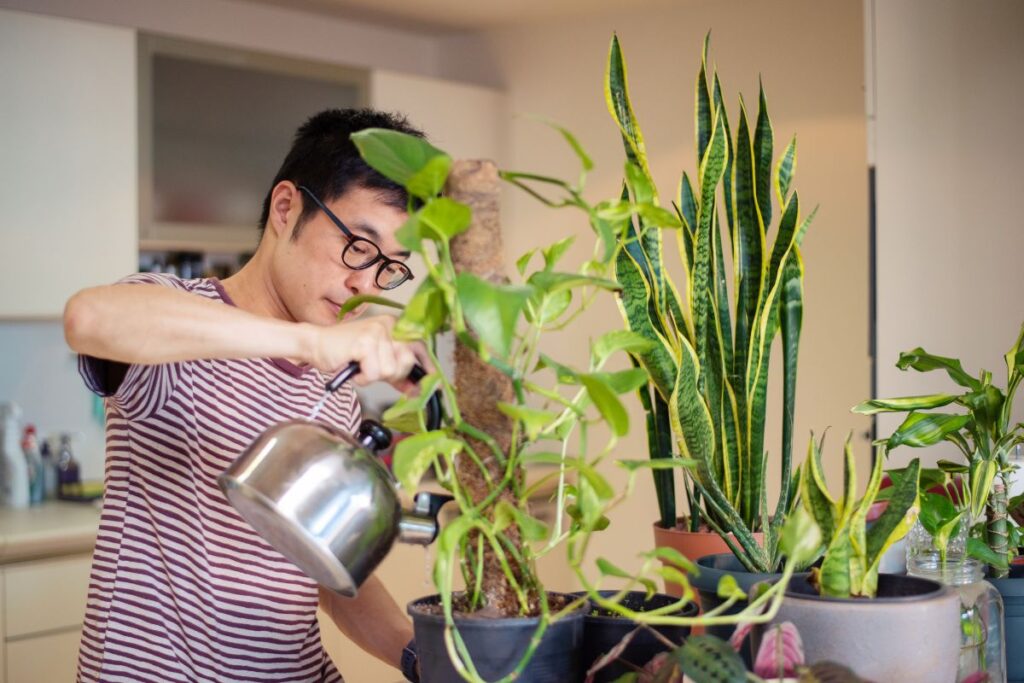
To ensure successful fertilization and maintain the health of your indoor plants, it’s essential to avoid common mistakes that can hinder their growth. Here are a few pitfalls to watch out for:
- Overfertilization: Applying too much fertilizer or fertilizing too frequently can lead to nutrient imbalances and plant damage. Always follow the recommended dosage and frequency specified by the manufacturer.
- Underfertilization: Conversely, underfertilizing your indoor plants can result in nutrient deficiencies, stunted growth, and lackluster foliage. Be attentive to your plants’ nutritional needs and provide adequate fertilization.
- Using the wrong fertilizer: Different plants have different nutritional requirements, so it’s essential to choose a fertilizer that matches their needs. Using the wrong type of fertilizer or one with imbalanced nutrient ratios can hinder growth.
- Neglecting soil health: Fertilizers are not a substitute for good soil health. Ensure your indoor plants are potted in well-draining soil and periodically replenish the soil with organic matter to maintain its fertility.
Not adjusting fertilization with changing seasons: Indoor plants may have varying nutrient requirements throughout the year. Adjust your fertilization schedule and dosage based on seasonal changes and the growth stage of your plants.
Related Reading:
- How To Fertilize Cucumber Plants For Your Best Harvest?
- Top 8 Ways To Fertilize Your Tomato Plants For Best Harvest Yet
- Maximizing Your Harvest With the Best Fertilizer For Pumpkins
- Pruning Zucchini Plant: Maximize Your Zucchini Harvest with Pruning
- Growing Nantes Carrots: Tips And Techniques For A Bountiful Harvest
- Comprehensive Guide On Growing Eggplant In A Pot
Conclusion
Proper fertilization is key to maintaining the health and vitality of your indoor plants. By understanding their nutritional needs, choosing the right fertilizer, and following proper application techniques, you can provide your green companions with the essential nutrients they require.
Remember to monitor your plants for signs of nutrient deficiencies or overfertilization and make adjustments as needed. With the right care and attention, your indoor plants will flourish, bringing beauty and serenity to your living space.
FAQs about Fertilizer for indoor plants
Here are some FAQs about fertilizing indoor plants.
Can I Use Outdoor Plant Fertilizer for Indoor Plants?
While outdoor plant fertilizers may contain similar nutrients, they are typically formulated for the specific needs of plants grown in garden soil. Indoor plants have different growing conditions and nutrient requirements, so it’s best to choose a fertilizer specifically formulated for them.
How Often Should I Fertilize My Indoor Plants?
The frequency of fertilization depends on the type of fertilizer and the needs of your indoor plants. In general, indoor plants are fertilized every 2–4 weeks during the growing season. However, always refer to the instructions provided by the manufacturer and consider the individual needs of your plants.
Should I Dilute Fertilizer for Indoor Plants?
The manufacturer’s instructions typically call for diluting water-soluble fertilizers before application. Dilution ensures that the fertilizer is not too concentrated, reducing the risk of overfertilization and potential damage to the plants’ roots.
Can Fertilizer Save an Overwatered Indoor Plant?
Overwatering harm is irreparable with fertilizers. Overwatering can lead to root rot and suffocation, depriving the plants of oxygen. It’s crucial to address the overwatering issue by adjusting watering practices and providing proper drainage before considering fertilization.
Can I Use Homemade Fertilizer for Indoor Plants?
Homemade fertilizers, such as compost tea or diluted organic matter, can be used for indoor plants. However, it’s important to ensure that homemade fertilizers are well-balanced and do not contain excessive amounts of nutrients that could harm the plants. Proper preparation and dilution are key.
Can I Use Fertilizer on Succulents?
Succulents have unique nutritional needs and are generally more tolerant of nutrient-poor conditions. While fertilizers can be used on succulents, it’s crucial to choose a fertilizer specifically formulated for these plants and to dilute it to avoid overfertilization. Always follow the manufacturer’s instructions and monitor the plants’ responses.
